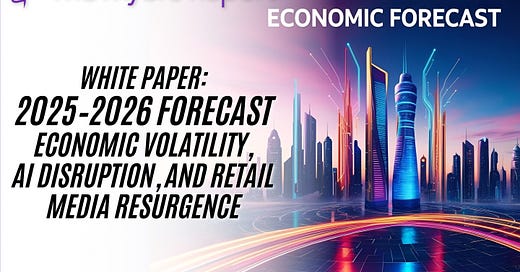Media's 2025 Economic Connections to 2009 and 2020
The 2025/2026 media economy, though not triggered by a singular crisis, is mirroring patterns observed during two of the most disruptive advertising downturns in modern history
Advertising’s response to economic turbulence has historically catalyzed long-term structural changes, particularly in how media budgets are allocated, commitments are structured, and performance is measured. The current 2025/2026 cycle, though not triggered by a singular crisis, is mirroring patterns observed during two of the most disruptive advertising downturns in modern history: the 2009 financial collapse and the 2020 COVID-19 pandemic. In each case, systemic disruption forced marketers to rethink their playbooks, accelerate experimentation, and embrace new models that ultimately redefined the media economy. in every downturn, the media economy doesn’t just recover, it evolves. The question for 2025/2026 is which players will be best positioned to capture the available budgets.
2009/2010: The Great Recession and the Rise of Performance Media
The 2008–2009 financial crisis led to a dramatic contraction in U.S. ad spending down more than 12% year-over-year with the brunt of the decline absorbed by print, broadcast, and local television. Brands pulled back from long-term media commitments, cut awareness campaigns, and prioritized short-term, performance-based channels. Digital media, then in its adolescence, saw a surge in direct-response advertising - email, paid search, affiliate marketing - delivering measurable ROI at a time when marketers were under pressure to justify every dollar. The crisis also fueled early investments in programmatic display and data-driven targeting.
The aftermath of the recession marked the beginning of digital’s ascendancy. The structural shift was clear: marketers no longer planned exclusively around mass-reach channels. They began demanding accountability and digital platforms were built to provide it.
2020/2021: COVID-19, Acceleration of Digital, and the Decline of Certainty
A decade later, the COVID-19 pandemic delivered another profound disruption. The advertising market initially collapsed in Q2 2020 as uncertainty reigned. But by Q3, a very different recovery emerged. Brands pivoted quickly to ecommerce, digital video, search, and streaming, where consumer attention had rapidly migrated. The Upfront marketplace faltered, many commitments were canceled or deferred as marketers prioritized agility over scale. At the same time, retail media networks such as Amazon Advertising and Walmart Connect emerged as performance-first alternatives that could tie ad spend directly to product sales.
By 2021, the digital ecosystem had firmly taken the lead. Streaming had become a mainstream ad channel. Social commerce and influencer marketing moved into the media budget mainstream. And the notion of locking in media dollars a year in advance became increasingly untenable for performance-obsessed marketers.
2025/2026: A Familiar Yet Evolved Disruption
While 2025 has not (yet) been defined by a singular crisis, the current climate reflects many of the same characteristics that shaped 2009 and 2020: economic instability, global uncertainty, cautious consumer spending, and accelerated digital maturity. The result is a similar pullback in long-term commitments - particularly in the Upfront market - and a renewed emphasis on flexibility, real-time performance metrics, and diversified digital strategies.
This time, however, buyers are armed with far more sophisticated tools. AI-powered planning platforms, proprietary data sets, and predictive analytics now guide decisions that were once driven by gut or legacy relationships. Holding companies have become intelligence organizations, leveraging dynamic simulations to manage risk and optimize returns.
The Upfront market, once a bastion of stability, is now a contested space. Buyers are willing to commit—but only on their own terms, and only when supported by data that suggests the investment will deliver. Sellers, meanwhile, must adapt to these new realities or risk being left behind, as happened in previous cycles.
Republished from The Myers Report 2025-2026 Marketing, Advertising & Media Economic Report, 75-pages of detailed economic data, forecasts, trends, opportunities, and future dynamics driving media budget allocation and growth opportunities. Available at www.myersreports.com to Myers Report subscribers and for purchase.





